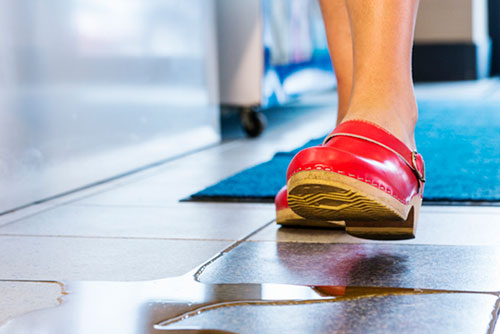People hurt other people. Sometimes its intentional, sometimes it is through carelessness, such as when a careless driver runs a red light and hurts or kills someone else. If the victim lives, he has to live with the consequences caused by injury, including wage loss, medical bills, and changes in how (or if) they can live their life. The person who caused the injury should pay for the damages they caused.
One of the most common types of cases we handle involves a fall from a slip or trip. Did you know that falls are the number two leading cause of injuries in the United States, or that every 35 minutes a senior adult dies as a result of fall, or that every day 25,000 people visit hospitals as a result of falls?
When a person walks, they look forward, not down. Under Florida law, a person or business is held liable when a walkway is unreasonably dangerous, such as if it is broken, unreasonably slippery or otherwise dangerous.
However, stores are not responsible when the floor is slippery because of a “transitory foreign substance,” such as a recently spilled soda. In order for the store to be held liable in those circumstances, the victim must show that the substance was on the floor for a long enough time that the store staff knew or should have known about it and cleaned it up:
768.0755 Premises liability for transitory foreign substances in a business establishment.—
(1) If a person slips and falls on a transitory foreign substance in a business establishment, the injured person must prove that the business establishment had actual or constructive knowledge of the dangerous condition and should have taken action to remedy it. Constructive knowledge may be proven by circumstantial evidence showing that:
(a) The dangerous condition existed for such a length of time that, in the exercise of ordinary care, the business establishment should have known of the condition; or
(b) The condition occurred with regularity and was therefore foreseeable.
Each case is extremely fact dependent. For example, in the recent case of Dominguez v. Publix, the appellate court was presented with these facts:
Dominguez slipped and fell on a patch of laundry detergent that spilled from the top of a bottle that had just fallen from a Publix Super Market store shelf. The video recording shows at the time the bottle fell a Publix manager was examining shelves at the opposite end of the aisle. Upon hearing the crash he ran to the spot of the spill. The manager then straddles the spill and bends over to right the bottle nine seconds after the bottle fell. Four seconds later, Ms. Dominguez rounds into the aisle and slips on the detergent. The manager’s back is to Dominguez as she turns into the aisle. As evidenced by the video camera, the entire incident, from the time the manager heard the bottle fall to the time Dominguez slipped, consumed thirteen seconds. Because such a short time passed between the spill and the fall, the court decided that Publix was not negligent and could not be held liable.
In Dominguez the court had a video to look at. Usually, there is no video. In that case, the victim must prove that the store had “constructive knowledge of the dangerous condition,” that is, that the store knew or should have known of the dangerous condition. For example, if the substance on the floor was dirty or had footprints in it, it implies it was there for a while and the store, if they had been making reasonable inspections, should have noticed and cleaned it up.
In another recent case, City of Miami v. Navarro, the same appellate court addressed the following facts:
Ms. Navarro tripped and fell over a raised brick paver on a sidewalk. She had to prove either that the City had actual knowledge of the sidewalk defect, of which there was no evidence, or constructive knowledge through some evidence that the sidewalk defect existed long enough that the City should have known of it.
In an attempt to establish the City’s negligence, Ms. Navarro relied upon a color photograph of the raised brick. She argued the raised brick was sufficient, by itself, to imply that the defect had existed for a significant period of time to establish the City’s constructive notice of the defect. The court held that there was nothing in the photo that implied that the brick had been out of place for a long time (such as weathering, erosion patterns, etc.) and therefore held that the City was not negligent.
So, slips and falls can be deadly but getting a successful legal result can be difficult without careful and exacting legal representation. It is critical that the attorney has the skill to develop the evidence to show negligence and carelessness where it exists. At Rader Law Group, LLC we have over 50 combined years of experience in litigating personal injury cases. For a free consultation to determine if you have a case, give us a call today.












